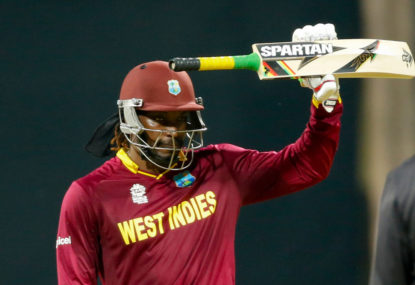Travis Head obliterates RCB in record breaking century... and just wait for the celebration!
RCB have suffered a massive HEAD-ACHE after Travis Head smashed the fastest century by an SRH player in just 39 balls, as they amassed…

This summer, Australia hosted the West Indies in a Test series which was never a contest. Australia won convincingly and, as a result, crowd figures, TV viewers and general interest were all significantly down.
We were told this was an opponent problem, not a cricket problem.
Past Australian players, journalists and armchair pundits alike were keen to spruik the death of cricket in the once great West Indian region as a result.
Their best players shunned the series and chose to participate in the Big Bash instead, an unthinkable and insulting act to any cricket fan over the age of 25. We hold Test cricket as the holy grail, followed by the length of the straight and then the 50 over format. Twenty20 and its zinger bails are a distant last.
No longer is that the case.
During the Test summer, representative cricket is now accompanied by the Big Bash. This 20-over competition has risen to prominence in its five-year existence, culminating in a crowd of 81,000 who turned up to watch the Melbourne Stars and Renegades go head-to-head at the MCG in early January.
This is in direct contrast to the lowly figure of 53,000 that attended the Test match on Boxing Day only days earlier at the same venue. To older viewers this is barely believable, to nine and 10-year-olds, this is all they’ve ever known.
Fast forward to last night.
The West Indies won the World T20 after Carlos Brathwaite belted four consecutive sixes in the last over against England. This is the same West Indies who were embarrassed during the Australian summer, the same West Indies who supposedly could no longer compete on the international stage.
I watched the entire tournament closely and have never seen such parity in a cricket tournament. Ten nations competed in the group stage and every single match was just that, competitive.
The best example of this was when the eventual champions were beaten by Afghanistan in a thrilling encounter. Some would say that is due to the randomness and luck of T20, but I disagree.
The nuance of cricket is still there, but with more on the line, every ball is tense, every captaincy error harshly punished. You can’t get any more out of a cricket game than what Twenty20 provides, nullifying the need for one-day matches.
The last four months may be a peek into the future of cricket. It’s certainly the first time I have considered T20 may become the dominant form of the sport.
Since its inception, people have said that Twenty20 will kill Test cricket, others have said it’s nothing more than a gimmick, a bastardised format which ruins all that is good about the sport but which won’t last long.
Looking at the Test landscape, there are only four nations who remain competitive – Australia, South Africa, England and India. Even then, South Africa’s long-term viability remains uncertain.
The rest of the cricket-playing world are moving to the shortest format and, with the recent Australian summer in mind, it’s more than fitting the West Indies claimed their second World T20 trophy.
It will be fascinating to see what the next ten years holds for international cricket.
Last night told me West Indian cricket certainly isn’t dead. Instead, they may be one step ahead of the rest of us.